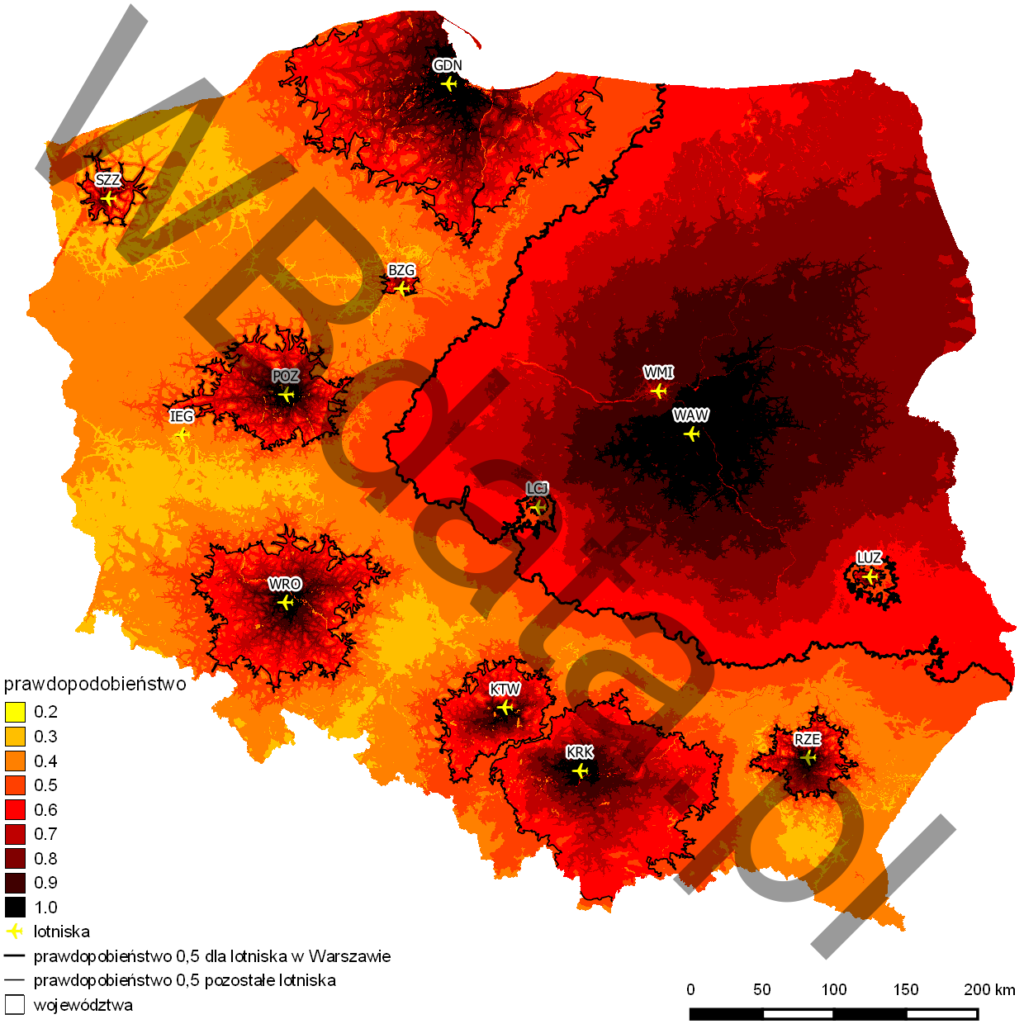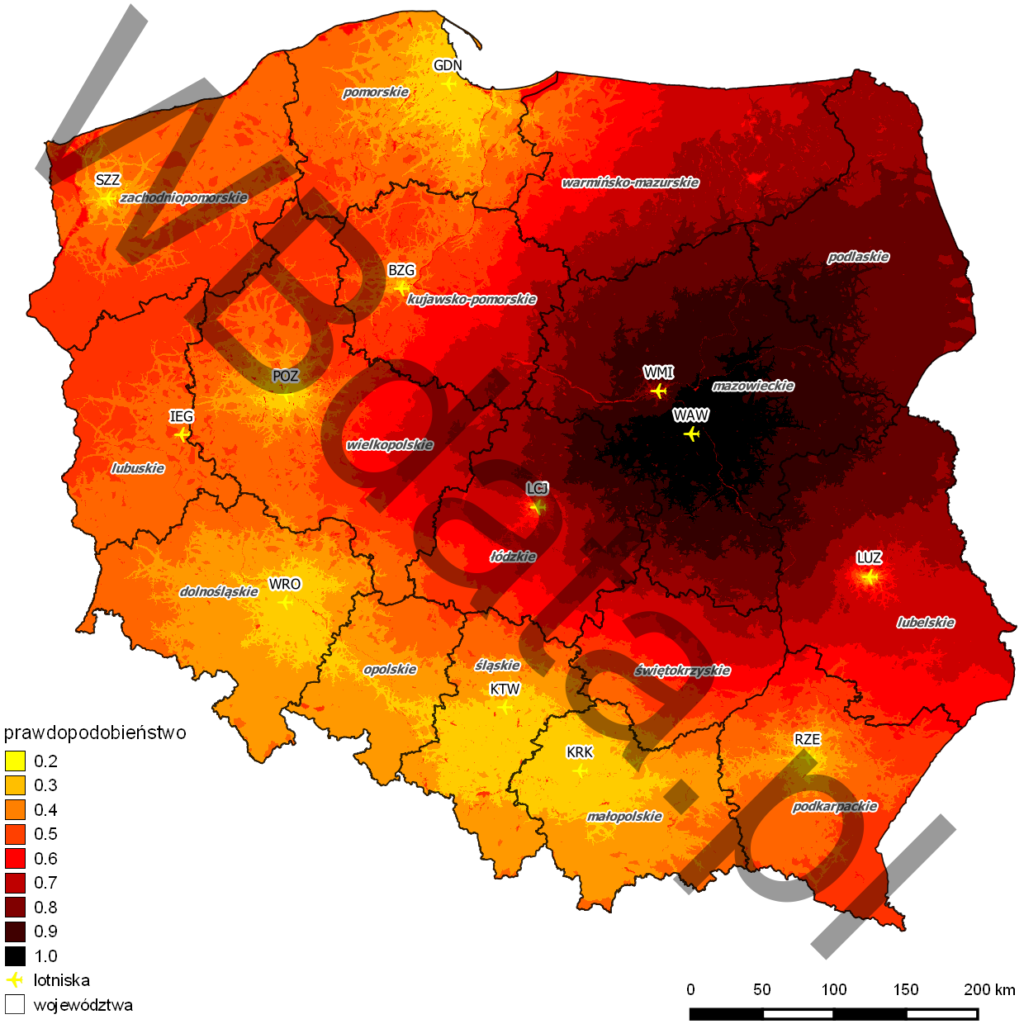[:pl]Jednym z elementów przestrzennych analiz geomarketingowych jest model probabilistyczny Huffa, który został opracowany już w 1962 roku przez D. L. Huffa. Jest to model ciążenia konsumentów do ośrodków handlowych na badanym obszarze. Według L.D. Huffa czas podróży i atrakcyjność ośrodka handlowego są czynnikami wpływającymi na zachowanie konsumenta i mogą służyć do prognozowania wyboru miejsca zakupów.
W przypadku niniejszej analizy, konsumentami będą pasażerowie, a ośrodkami handlowymi lotniska. Atrakcyjność lotniska została wyrażona ilością pasażerów danego portu lotniczego w 2013 roku wg danych Urzędu Lotnictwa Cywilnego.
Wzór na model Huffa wygląda następująco:

gdzie:
Pij – prawdopodobieństwo, że pojedynczy pasażer zamieszkały w regionie i skorzysta z lotniska j,
Sj – liczba pasażerów lotniska j,
Tij – czas niezbędny na przemieszczenie się pasażera z regionu i do lotniska j,
a – parametr szacowany empirycznie, odzwierciedlający wpływ czasu podróży na przemieszczenia związane z zakupami.
Wynik analizy przedstawiono na poniższej mapie.

Przedstawia ona stopień prawdopodobieństwa wybrania przez potencjalnego pasażera danego portu lotniczego. Największy obszar z wysokim prawdopodobieństwem (powyżej 0,5) znajduje się wokół portu lotniczego Warszawa Okęcie. Założeniem modelu jest to, że im więcej pasażerów lotniska, tym bardziej atrakcyjne. Jak wiadomo, lotnisko Okęcie ma największą ofertę przewozów i najwięcej pasażerów.

Kolejna mapa pokazuje model Huffa tylko dla portu lotniczego Okęcie. Widoczne jest zmniejszanie się stopnia prawdopodobieństwa w okolicach innych portów lotniczych, które stanowią mniejszą lub większą konkurencję dla Okęcia.
Za pomocą modelu można następnie obliczyć liczbę ludności obszaru objętego największym prawdopodobieństwem wybrania tego portu lotniczego jako miejsca początku podroży, liczbę klientów, liczbę dochodów lotniska…
W niniejszej analizie nie brano pod uwagę lotnisk znajdujących się poza granicami Polski.
Taka analiza może być przydatna dla wielu innych dziedzin biznesu, takich jak handel, bankowość, branża medyczna itp.
Skorzystano ze strony Encyklopedii Zarządzania: http://mfiles.pl/pl/index.php/Model_probabilistyczny_Huffa
Analizy geomarketingowe[:en]One of the elements of spatial geomarketing analyses is Huff’s probabilistic model, which was developed in 1962 by D.L. Huff. It is a model that calculates gravity-based probability of consumers to select certain retail shopping location in the area examined. According to L.D. Huff, travel time and attractiveness of a retail shopping location are the factors that affect consumer behaviour and can be used to predict the preference of certain shops.
For this analysis, the passengers are consumers and the airports are retail locations. The attractiveness of an airport has been expressed as the number of passengers of a given airport in 2013, as per the data from the Civil Aviation Authority.
The Huff model formula is as follows:

where:
Pij – the probability that a single passenger residing in the region i will avail of the airport j,
Sj – the number of passengers availing of airport j,
Tij – the time required for movement of a passenger from the region i to the airport j
a – the parameter estimated empirically, reflecting the impact of travel time on movements related to shopping.
The analysis results are shown in the map below.

It shows the probability degree of selecting an airport concerned by a potential passenger. The largest area with a high degree of probability (above 0.5) is the area around Warsaw Chopin Airport. The model is based on the assumption that the more passengers an airport has, the more attractive it is. As we all know, Warsaw Chopin Airport has the largest offer of journeys and the largest number of passengers.

Another map shows the Huff model for Warsaw Chopin Airport only. It can be observed that the degree of probability decreases in the vicinity of other airports that constitute a less or more significant competition for Warsaw Chopin Airport.
This model can be used to calculate the population of an area with the largest probability of selecting the airport concerned as a starting point for a journey, number of clients, airport revenue…
This analysis did not account for the airports beyond Polish borders.
Such analysis can be useful for many other areas of business such as trade, banking, medical industry, etc.
The Encyclopaedia of Management has been used: http://mfiles.pl/pl/index.php/Model_probabilistyczny_Huffa
Geomarketing analyses[:]
